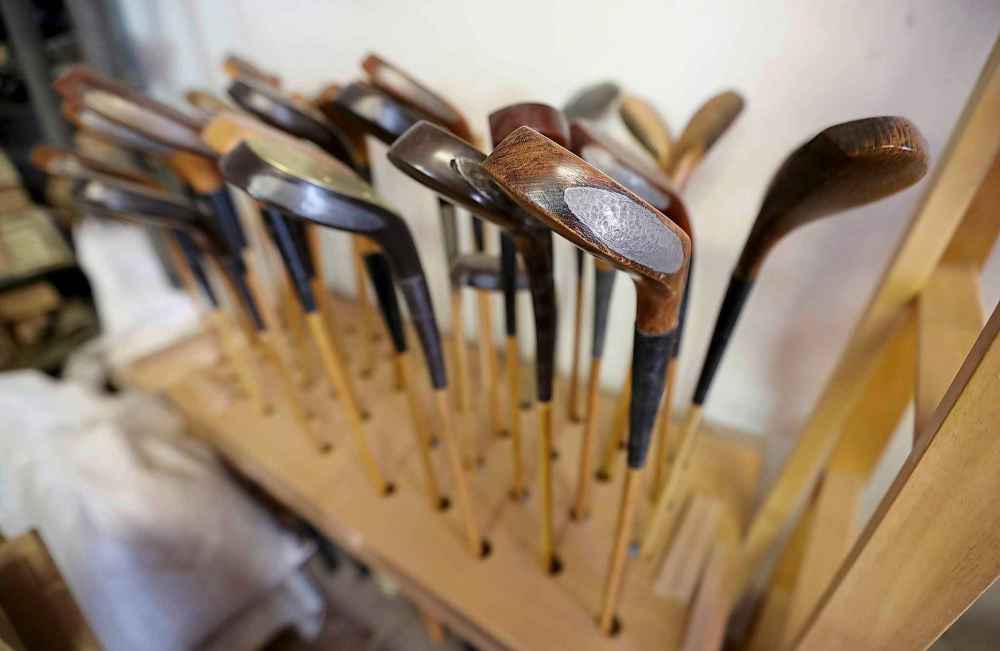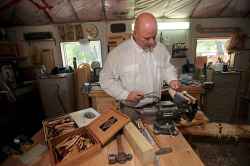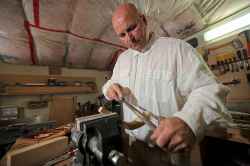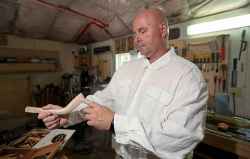Any way you slice it, his clubs got game In his West St. Paul workshop, Kelly Leonard recreates classic wooden clubs that harken back to golf's storied past
Read this article for free:
or
Already have an account? Log in here »
To continue reading, please subscribe:
Monthly Digital Subscription
$0 for the first 4 weeks*
- Enjoy unlimited reading on winnipegfreepress.com
- Read the E-Edition, our digital replica newspaper
- Access News Break, our award-winning app
- Play interactive puzzles
*No charge for 4 weeks then price increases to the regular rate of $19.00 plus GST every four weeks. Offer available to new and qualified returning subscribers only. Cancel any time.
Monthly Digital Subscription
$4.75/week*
- Enjoy unlimited reading on winnipegfreepress.com
- Read the E-Edition, our digital replica newspaper
- Access News Break, our award-winning app
- Play interactive puzzles
*Billed as $19 plus GST every four weeks. Cancel any time.
To continue reading, please subscribe:
Add Free Press access to your Brandon Sun subscription for only an additional
$1 for the first 4 weeks*
*Your next subscription payment will increase by $1.00 and you will be charged $16.99 plus GST for four weeks. After four weeks, your payment will increase to $23.99 plus GST every four weeks.
Read unlimited articles for free today:
or
Already have an account? Log in here »
Hey there, time traveller!
This article was published 19/07/2018 (2700 days ago), so information in it may no longer be current.
Since this is British Open weekend, let’s tee things off with a story related to Willie Park, the inaugural winner of the Open Championship, the oldest of professional golf’s four major tournaments.
Kelly Leonard is the founder of K. Leonard Hickory Golf, a West St. Paul-based business that markets hand-built wooden golf clubs — replicas of the type employed in the latter half of the 19th century. In 2016, Leonard was contacted by a person from California who was after the specific style of hickory-shafted putter Scottish-born Park used in 1860 to win the first of his four British Open titles.
There was a hitch: while Park was a right-handed shot, Leonard’s customer was a leftie, meaning there was a fair bit of trial and error involved before he got the angles and grooves of the club just right.

“After all was said and done, I ended up making six left-handed putters before I was satisfied with the end-result. And because I liked the look of it so much, I made eight right-handed Willie Park putters, as well,” Leonard says, standing in his home garage-turned-workshop. “But I don’t want to give the impression I’m some great golf club designer. All I’m doing is recreating styles and shapes these absolutely great club-makers already came up with 150 years ago.”
About 20 years ago Leonard, 49, taught himself how to make cigar humidors out of Spanish cedar; not because he smokes stogies but simply because he liked the look of the lined containers cigar aficionados store them in.
In 2005, while he was on the internet researching new humidor designs, the married father of one was redirected to a website devoted to Hugh Philp (1786 -1856), a golf club designer whose handiwork has been described as the “Stradivarius of (golf) clubs.” Intrigued, he switched off his computer and headed to his workshop to try and replicate what he’d spotted online.
LEONARD’S HONOUR
In 2016, Kelly Leonard was approached by the producers of Tommy’s Honour, a film based on the book Tommy’s Honor: The Story of Old Tom Morris and Young Tom Morris, Golf’s Founding Father and Son,cited by Britain’s The Telegraph as one of the 50 greatest sports book ever written. In exchange for tickets to the film’s premiere in New York City, the production company behind Tommy’s Honour wanted to borrow some of Leonard’s clubs to drum up interest for their project.
In 2016, Kelly Leonard was approached by the producers of Tommy’s Honour, a film based on the book Tommy’s Honor: The Story of Old Tom Morris and Young Tom Morris, Golf’s Founding Father and Son,cited by Britain’s The Telegraph as one of the 50 greatest sports book ever written. In exchange for tickets to the film’s premiere in New York City, the production company behind Tommy’s Honour wanted to borrow some of Leonard’s clubs to drum up interest for their project.
“The way I understood it, they were supposed to set up at the PGA’s Houston Open with a big banner promoting the movie, and a booth or something with my clubs for anybody who wanted to try them out,” he says. “I’m not sure if that came to pass or not but it was an honour to be asked.”
Leonard’s review of the movie? “It didn’t do as well as they were hoping but it’s a fantastic movie, nonetheless. But it’s funny; when I watch something like that or (2005’s) The Greatest Game Ever Played(which starred Shia LaBeouf as Francis Ouimet, the first amateur golfer to win the U.S. Open), I’m not paying as much attention to the plot as the clubs in the actors’ hands. Later I’ll have conversations with other (club) builders and we’ll discuss whether a particular putter was the right one or not for the time period depicted.”
“People have asked how long it took to make that first club and I don’t really have an answer,” says Leonard, who taught himself how to golf at the age of 10 by turning a section of his parents’ five-acre farm near Hazelridge into a quasi-driving range. “It was a lot of me cutting and sanding one piece of wood, then going back on the computer to see what my next step was going to be. But to be completely honest, I totally lose track of time when I’m building these things. Quite often my wife will tell me supper’s on the table only to return four or five hours later before going to bed to remind me I still haven’t eaten.”
It was while studying Philp’s technique that Leonard learned there are groups of golfers in various parts of the world who play the game based entirely on mid-19th century rules: organizations such as New Jersey’s Society of Hickory Golfers and Helsinki’s Finnish Golf Historic Society whose members not only dress the part in tams and knee-highs, but use wood-shafted clubs to hit gutta percha golf balls, or gutties, from hole to hole. (Considering one manufacturer in the United States charges US$20 per guttie, Leonard agrees with a reporter who opines at that price, what hickory golfer in their right mind would ever set foot on a course laden with water hazards.)
Now that he knew there was a market for his new hobby, Leonard spent the next two years perfecting his craft. During that period he also reached out to Chris McIntyre, founder of San Diego-based Play Hickory, Inc., a manufacturer whose clubs have been in the hands of PGA stars such as Ricky Fowler, Luke Donald and Justin Rose.
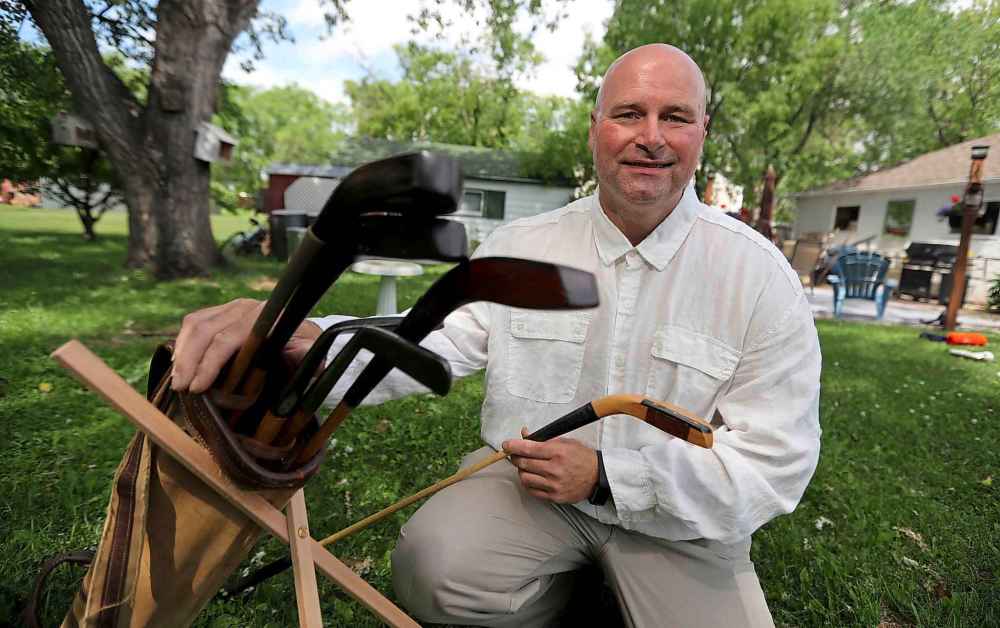
“He’d been in the business for a while and happily answered every question I threw at him. The last time we talked was about a month ago, in fact, because in this line of work research and development never ends. After 13 years of building clubs, I sometimes like to think I know everything there is to know. The truth is I’ve barely scratched the surface.”
One of the questions Leonard fields most often is, “Sure, your clubs look great but how functional are they?” To demonstrate their effectiveness, Leonard often sets up a booth at fundraising tournaments or Texas scrambles where he invites participants to give his clubs a shot. (Unlike modern golf, where players are permitted to carry 14 clubs in their bag, hickory golfers use six clubs max, including a brassie, the equivalent of a driver, a mashie, which has a range of about 150 yards, and a niblick, or wedge.)
‘After 13 years of building clubs, I sometimes like to think I know everything there is to know. The truth is I’ve barely scratched the surface’– Kelly Leonard
“One time on the 13th hole at Pine Ridge, Tyler Mancini, a golfer who was on the Canadian Tour at the time, picked up one of my drivers, took two or three practice swings then dead-smoked it 250 yards, which is about as far as you can hit with these things, straight up the middle of the fairway. So yeah, they work alright.”
Rick Lemoine is the director of golf at Transcona Golf Club. In April he and a few of his fellow members were cleaning out a storage room at the Dugald Road golf course when he spotted some wood-shafted clubs gathering dust in a corner.
A student of the game, Lemoine’s initial reaction was “oh, cool,” a response that quickly changed to “OH, COOL!,” when he realized the shafts were made out of hickory.
“And then when I realized they were left-handed to boot I nearly lost my mind,” says the southpaw, who was only too happy to ask the club’s executive members how much they wanted for the lot.
On further inspection, Lemoine realized one of the clubs was damaged. Hoping to salvage it, he went online, typing “repair” and “hickory golf club” in the search engine. After being led to Leonard’s website, he sent a message via the contact link, mentioning he lived in Winnipeg. Because there is nothing on Leonard’s webpage indicating his home address, imagine Lemoine’s surprise when he got a reply from Leonard that ended with, “When do you want to drop your club off?”
“I was like, ‘Drop it off?’ When he told me he lives in West St. Paul I was like, ‘You’ve got to be kidding; I’ll be there in 20 minutes.’”
Lemoine uses his hickory clubs at least once a week, generally Sunday nights when he and his wife play 10 holes before retiring to the clubhouse for dinner.
“Four or five over par, so not much different than I shoot with my regular clubs,” he says when asked what kind of scores he posts. “But with these clubs it’s more about having fun than shooting a good round. I’ve been golfing a long time and in a way, hickory golf makes the sport feel new again. When I catch one just right and look up to see the ball’s got a really nice flight to it I usually break out laughing, saying ‘Holy cow.’”
Leonard, who has shipped clubs as far as India and Australia, says business might be a bit of a misnomer for his, uh, business. For a long time, he was selling one club for every 15 he made – not exactly the most economically sound approach, he admits.
“While the bullseye for a company like Titleist is the size of the Grand Canyon, my bullseye is super small. But when I started 13 years ago it wasn’t about money, it was about making myself one club,” says Leonard, who also helps run a family-owned construction operation. “Obviously at some point you have to make a dollar or two to justify what you’re spending on tools, no matter how much you love what you’re doing. So yeah it’s a business; I’m just not sure it’s one you want to buy stock in, just yet.”
david.sanderson@freepress.mb.ca
Dave Sanderson was born in Regina but please, don’t hold that against him.
Our newsroom depends on a growing audience of readers to power our journalism. If you are not a paid reader, please consider becoming a subscriber.
Our newsroom depends on its audience of readers to power our journalism. Thank you for your support.

